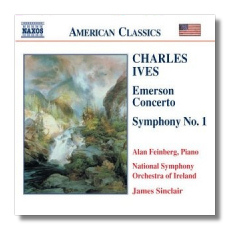
The Internet's Premier Classical Music Source
Related Links
- Ives Reviews
- Latest Reviews
- More Reviews
-
By Composer
-
Collections
DVD & Blu-ray
Books
Concert Reviews
Articles/Interviews
Software
Audio
Search Amazon
Recommended Links
Site News
 CD Review
CD Review
Charles Ives

- Emerson Concerto
- Symphony #1
Alan Feinberg, piano
National Symphony Orchestra of Ireland/James Sinclair
Naxos 8.559175
Summary for the Busy Executive: Ives and sort-of Ives.
One of Ives' advantages given him by his obscurity was that, in the absence of a commission or publication, he never actually had to complete a piece. He could tinker to his heart's content. When Kirkpatrick came to play for him the Concord Sonata, Ives kept shoving sketches at him newer than the published version. My Ives scholarship is sketchy at best, and I've wondered whether the "standard" version nowadays incorporates those pages. At one point, Ives contemplated a series of orchestral works on "Men of Literature," and got as far as writing the Robert Browning Overture. He also considered orchestral pieces on Hawthorne and Emerson. The Hawthorne music got incorporated into the Concord Sonata, as did many of the ideas for the Emerson piece, which began life as a work for piano and orchestra. We have here a reconstruction of that version cast as a concerto.
The liner notes drive me crazy, quite frankly. They claim that the Ives manuscript was "two stages" away from a final state. I have no idea specifically what that means or how much the resurrector, David G. Porter, pieced together, cleaned up, or made up. I can therefore judge the work only by the criterion of how much it sounds like Ives to me. One might ask what seems superficially like a Philistine question: "How can you tell?" But it does possess some validity. I would answer that Ives creates a quite individual sound, however cacophonically it may strike certain ears. I suppose one can seek out the technical reason in the details of a score (which I don't have), but one's own ears detect a characteristic "harmonic" and orchestral texture throughout Ives' large scores. You can ask yourself whether it sounds like Three Places in New England, the Three Harvest Home Carols, Psalm 90, Symphony #4, From the Steeples and Mountains, and so on.
With those guides, I ask myself how far I can suspend disbelief to consider the concerto as an Ives work. Alternately, how much insight does the reconstruction into Ives' composing procedures does this score provide? First, it seems to me that only the opening and final movements sound all that much like Ives, with the start very close to the "Emerson" movement of the Concord Sonata. The second movement (each movement, by the way, follows its predecessor without pause) sounds too clean, particularly the brass writing – the "chords" too conventionally spaced and the counterpoint, the frequency of independent simultaneous events, too lined-up. So that part of the score actually does yield, through negative example, some understanding of Ives' compositional habits. I can't call the concerto, neither compelling on its own (as Deryck Cooke's Mahler Tenth) nor particularly historically illuminating (as Mahler's orchestration of Beethoven's Ninth), a necessary addition to the Ives canon.
Ives wrote his First Symphony as his graduation thesis from Yale. Ives had studied with American Wagnerian Horatio Parker, who after one attempt by Ives to work on his experiments, kept Ives to the grindstone of late Romantic craft. For all of Ives' sniping later on at Parker and at what he considered Parker's aesthetic gentility, Ives received a thorough professional training from Parker, and the First Symphony is a thoroughly professional piece of work. The myth of Ives as the Yankee farmer inventing time machines in the barn is precisely that. What we may sense as tameness is so only compared to Ives' experimental work. This is a modern symphony, and the modern in question is Dvořák, in 1898 an inspirational figure in the United States. The "New World" symphony has been around for only five years. One sees the superficial influence of idiom in Ives' opening theme, a symphonic waltz (along the lines of the Dvořák Sixth), in the "Going Home"-like slow movement, and in the rhythmic syncopations and piquant orchestration of the scherzo. Below the surface, however, Ives picks up the Czech's more basic advancements. Among other things, Dvořák streamlined sonata-allegro form, finding ways to elide sections (especially compared to most of Brahms' symphonies, excepting the third). Ives continues innovating, even in a relatively conventional context. For one thing, the first movement modulates through all key centers, at one remarkable point giving up any effort at thematic development and having the orchestra just play chords. I like this symphony a lot. For its time and place, it stands out from most of Ives' established contemporaries. I can think of only one American symphony of the time any better – the "Gaelic," by Amy Beach. Chadwick's Symphonic Sketches also strike me as more realized, but all three works represent 19th-century American music at its best.
Unfortunately, Sinclair and his Irish band seem to have no interest in the symphony at all. In the scherzo, the playing begins to show a pulse, but this is almost always the liveliest movement anyway. The massive first movement limps along in a daze. There are so many better performances – Gould, Ormandy, Järvi, Thomas, even Mehta – that you really shouldn't waste your time with this one. I can recommend the CD for the concerto to those Ives head-bangers who must have everything.
Copyright © 2008, Steve Schwartz




















